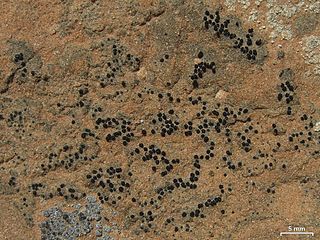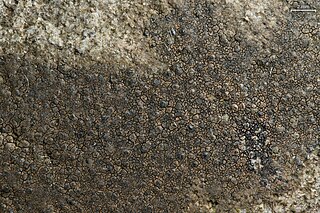
The Verrucariaceae are a family of mostly lichenised fungi in the order Verrucariales. The lichen-forming species, which comprise the vast majority of the family, have a wide variety of thallus forms, and include crustose (crust-like), foliose (bushy), and squamulose (scaly) representatives. Several characteristics of the spore-bearing structures, the ascomata, define the family, including their perithecioid form–more or less spherical or flask-shaped, with a single opening and otherwise completely enclosed by a wall. Squamulose members of the Verrucariaceae with simple ascospores, and without algae in the spore-bearing region are known as catapyrenioid lichens; there are more than 80 of these species. The family has several dozen lichenicolous (lichen-dwelling) examples, including a few genera that contain solely lichenicolous members. An unusually diverse variety of photobiont partners have been recorded, mostly green algae, but also brown algae and yellow-green algae.

Staurothele is a genus of saxicolous (rock-dwelling), crustose lichens in the family Verrucariaceae. It has about 40 species. When the fungus is part of a lichen, the genus of lichen is commonly called rock pimples.
Nanostictis caucasica is a species of lichenicolous (lichen-eating) fungus in the family Stictidaceae. It is known to occur only in a single locality in the North Caucasus region of Southern Russia, where it grows parasitically on the foliose lichen Parmelia sulcata.
Heteroplacidium zamenhofianum is a species of lichenicolous (lichen-eating) lichen in the family Verrucariaceae. As a juvenile, it is parasitic on some members of the lichen genus Staurothele, but later becomes independent and develops a brown, crustose thallus. Characteristic features of the lichen include its dark brown, somewhat squamulous thallus and relatively small ascospores. It is widely distributed in Europe and North America.

Bacidina pycnidiata is a species of crustose lichen in the family Ramalinaceae. It is widely distributed in Europe and North Asia. It is characterised by its whitish or cream-coloured pycnidia with long and ostiolar necks.
Atla oulankaensis is a rare species of saxicolous (rock-dwelling) lichen in the family Verrucariaceae. It has been recorded in Finland and in the Canadian arctic, growing on calciferous rock and on high-pH soil.

Willeya is a genus of saxicolous (rock-dwelling), crustose lichens in the family Verrucariaceae. It has 12 species. Most species are found in southeast Asia, although individual representatives are known from Australia, Europe, and North America.
Sporodictyon is a genus of crustose lichens in the family Verrucariaceae. It has 10 species. Most species grow on rocks, although some have been recorded overgrowing soil and mosses.
Verrucaria oulankaensis is a rare species of saxicolous (rock-dwelling) crustose lichen in the family Verrucariaceae. It is found in north-eastern Finland, where it occurs on calcareous rocks on river shores.
Verrucaria ahtii is a species of saxicolous (rock-dwelling) crustose lichen in the family Verrucariaceae. It is found in Finland, Lithuania, Russia, and Switzerland, where it occurs on calcareous pebbles.
Atla recondita is a rare alpine species of saxicolous (rock-dwelling), crustose lichen in the family Verrucariaceae. Found in Sweden, it was formally described as new to science in 2015 by Sanja and Leif Tibell. The type specimen was collected from Hamrafjället at an altitude of 1,075 m (3,527 ft); there, it was found growing on calciferous rocks. It is known only from a few locations in this area, collected at an altitude range between 610 and 1,075 m. The lichen has a thin olive brown-coloured thallus and ascospores with 9–15 transverse septa and 3–4 longitudinal septa. The authors note that it is not possible to distinguish this species from the similar Polyblastia by morphology alone.
Atla praetermissa is a species of saxicolous (rock-dwelling), crustose lichen in the family Verrucariaceae. Found in Scandinavia, it was formally described as a new species in 2008 by Sanja Savić and Leif Tibell. The type specimen was collected in Andersjöåforsen. In addition to Sweden, it has also been recorded in Norway; it grows on calcareous rocks near streams, at altitudes ranging from 165 to 955 m. The lichen has a superficial, thin and sometimes mesh-like, crustose thallus that is grey to dark green, sometimes with a brownish tinge. Its ascospores are narrowly ellipsoidal and measure 44.7–49.2 by 19.0–22.4 μm. Atla praetermissa has an unidentified green alga as a photobiont.

Heteroplacidium compactum is a species of areolate, crustose lichen in the family Verrucariaceae. It has a cosmopolitan distribution. It is a lichenicolous lichen, growing as a facultative parasite on other lichens, typically on non-calcareous rock. It has rod-shaped (bacilliform) conidia measuring 5–7 μm long, and ascospores that are 11–18 by 8–10 μm. Heteroplacidium zamenhofianum is a closely related species distinguished by having perithecia situated in the algal layer, and smaller ascospores with a more narrow ellipsoid shape.

Catapyrenium boccanum is a species of squamulose (scaley), rock-dwelling lichen in the family Verrucariaceae. It grows on mortar or on calcareous rock. Its squamules are up to 4 mm wide, pale to dark brown with black margins and a black underside. Ascospores measure 11–15 by 5–8 μm. Because of its combination of squamulose thallus, simple ascospores, and lack of algae in the hymenium, this species is a "catapyrenioid" lichen, of which more than 80 exist in the Verrucariaceae.
Wahlenbergiella tavaresiae is a species of saxicolous (rock-dwelling), crustose lichen in the family Verrucariaceae. Known from several locations in the San Francisco Bay area of the United States, it is a marine lichen that inhabits intertidal zones, and as such is immersed in seawater on a regular basis. Associated algal species include the red algae Hildenbrandia and Mastocarpus papillatus, and the brown algae Pelvetiopsis and Fucus. Petroderma maculiforme, a brown alga, is the photobiont partner in the lichen.
Phylloblastia fortuita is a species of foliicolous (leaf-dwelling) lichen in the family Verrucariaceae. Found in Western Europe and North America, it was formally described as a new species in 2009 by Esteve Llop and Antonio Gómez-Bolea. The type specimen was collected from Sant Medir at an altitude of 220 m (720 ft), where it was found growing on the leaves of Ilex aquifolium. The lichen, originally documented as occurring in the Mediterranean climate of the Iberian Peninsula, was reported from Marin County, California, in 2016. Other plants from which it has been documented include Buxus sempervirens, Hedera helix, Quercus ilex, and, in North America, Sequoia sempervirens.
Phylloblastia inexpectata is a species of foliicolous (leaf-dwelling) lichen in the family Verrucariaceae. Found in Europe, it was formally described by lichenologists Emmanuël Sérusiaux, Brian John Coppins, and Robert Lücking. The type specimen was collected by the second author in Dunskey Glen Woods, where it was found growing on the leaves of a Prunus laurocerasus tree growing near a stream. It has also been collected in England, southern Italy, Madeira, and Spain.
Staurothele nemorum is a species of saxicolous (rock-dwelling) lichen in the family Verrucariaceae. Found in the United States, it was formally described as a new species in 2019 by Caleb Morse and Douglas Ladd. The type specimen was collected from the University of Kansas Ecological Reserves, in Baldwin City (Kansas). The species epithet nemorum, which combines the Latin roots nemus and -oris, alludes to the habitat of this lichen. It occurs in the southern Great Plains in central North America, and has been collected in the states of Kansas, Missouri, Oklahoma, and Texas. It prefers dry sites, often on south- and west-facing exposures, where it grows on pebbles and cobbles of limestone and calcareous sandstone.
Verrucaria simplex is a species of saxicolous (rock-dwelling), crustose lichen in the family Verrucariaceae. Found in Europe and Asia, it was described as new to science in 1988 by lichenologist Patrick McCarthy. The type specimen was collected by Brian Coppins from Morpeth, Northumberland; there, it was found growing on a fragment of mortar-cement lying on the floor of a woodland. The lichen was later reported from the Czech Republic, and Korea.
Verrucaria nodosa is a species of saxicolous (rock-dwelling), crustose lichen in the family Verrucariaceae. Found in freshwater habitats in Wales, it was formally described as a new species in 2013 by lichenologist Alan Orange. The type specimen was collected by the author north-west of Llanuwchllyn, Merioneth, where it was found growing on an unshaded rock in a stream. The lichen has a grey-green to dark brown thallus with an uneven surface crust. Its ascomata are in the form of somewhat convex to hemispherical perithecia measuring 220–460 μm in diameter, with an inconspicuous or tiny ostiole. Ascospores are ellipsoid and colourless, lack any septa, and typically measure 20.5–22.2–24.0 by 90–97–105 μm. The species is known only from a few streams in Wales, where it grows on shaded or lightly shaded rocks. Associated lichen species include Ionaspis lacustris, Rhizocarpon lavatum, Porpidia hydrophila, Sporodictyon cruentum, and Trapelia coarctata, as well as the mosses Racomitrium aciculare and Scapania undulata.






